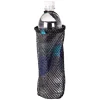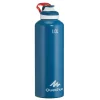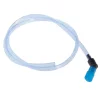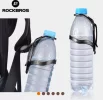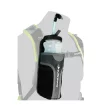Rob, I know you understand that my post below is not a critique about what you or anyone else prefers as a water carrying system or what handles best or what feels more 'natural' in usage. I want folks to use what makes sense to them, and seems the best choice. Those factors for choosing are all
subjective issues which no one can dispute.
I simply will not tell someone that bottles are bad, reservoirs are the best. I am limited to telling people WHY I might prefer one over the other, and they can legitimately do likewise.
This post is written to dispel myths which are commonly used to try and claim that reservoirs are either less sanitary to use, or are less easy to use than bottles. This is quite different than how someone 'perceives' usability as was mentioned above regarding the subjective value to the individual.
I'm
NOT writing this post to suggest that I and others who prefer reservoirs are making the best and most superior choice; I am posting this to preempt those who misstate facts - or who have insufficient facts -to claim that using hydration reservoirs is the WRONG way to go.
1.
Sanitation. With water carry, bottles have no advantage. Reservoirs stay just as sanitary. They do not require cleaning every day, nor do they need to be dried.
As with plumbing, it is the change of water and water flow through frequent use which keeps bottles, reservoirs, and tubing fresh and sanitary. With normal use, both bladders and bottles are constantly refilled and emptied That keeps them sanitary
UNLESS contaminated water is introduced, or other fluids with sugars (juices, energy drinks, soda pop, etc) are put into a bottle or a reservoir.
While working for the local public health district, I did a review of the literature, which I again did in 2016. Comparisons of bacterial contamination levels between bottles and hydration bladders were indistinguishable -- both had equally low rates of bacterial contamination. And both were at about equal risk for developing significant levels of bacteria and mold if not cleaned and dried properly prior to storage. In the last few years, the hydration reservoirs have become more modular in nature and have wider openings to access the water compartments, making it much easier to clean and prepare for storage than previous generations of the product.
One example study, from 2009:
https://www.wemjournal.org/article/S1080-6032(09)70419-3/fulltext
When it is time to store bottles or bladders away for the season, they can be sanitized if desired with a bit of bleach added to the final rinse water during cleaning. It is not necessary, but there is no harm in doing so. Then they can be rinsed out and be allowed to dry.
Molds and other nasty things occur if either container is stored
with water over a period of time, or have contained other fluids which might have sugars and then are not properly washed out prior to long term storage. Mold may also form in the shorter term when fluids with sugars are exposed to warmth and sun.
Also, not all discolorations are harmful molds. Most times, it may be an algae growth from leaving stagnant water exposed to light.
2.
Ease of Use. I find it personally easier to raise the mouth tube on my shoulder strap to drink from. I do not like to reach around to a side pocket, or even need to take off my pack to do so. I definitely do NOT like stuff hanging on my shoulder straps like bottles of water.
Again, this is personal preference, not an issue of something being 'better'. Access water bottles is not an issue of usability for bottle users.
3.
Weight. Here is where two major claims are made, one is correct and the other is not.
A typical empty 2 liter reservoir weighs around 4 to 6 ounces. The equivalent in bottles around 1.5 to 3 ounces. Depending on bottle material used, though, bottles can weigh up to 8 ounces.
So while it is correct that bottles can weigh less, it is not a significant issue of consideration with overall backpack weight.
The other issue is reservoir water capacity and total weight.
You do not have to fill a reservoir to the tippy top. I will carry as much water as I
need to carry from water source to water source. If the next water source is 32 kilometers distant under a hot sun, I will carry up to 4 liters. If the next water source is a few kilometers distant in cool weather, I might carry a half liter.
4.
Refills. This is actually a subheading under 'ease of use', but it is frequently pointed to as why bottles are better than reservoirs.
I can refill my reservoir without even removing my backpack. One does
not need to pull a reservoir out of the pack. It is a matter of using a quick disconnect system which is a simple and cheap add on accessory.
For those interested in adding a Quick Connect adapter to your hydration reservoir/bladder, I've added a link below. With the quick disconnect added, I don't even need to remove my backpack or daypack to do a quick and easy refill of the bladder.
NOTE: The video shows the quick disconnect being used
with a water filter as used when wilderness backpacking. However, on camino I leave off the filter altogether. The refill cap is simply attached to my collapsible water bottle, after it is filled with water from a fountain or faucet.
For refill bottles.... I use an
extremely lightweight collapsible bottle that can hold up to 1.5 liters. Empty, it rolls down to a small bundle that are easily stashed in an outside pocket.
Many times, I will carry 1/2 liter in the collapsible bottle as a quick backup as the weather or the distance between water refills dictates. So, if I decide to, say, carry 1 liters of water between water resupply points, I will fill the reservoir with 1/2 liter, and then carry 1/2 liter in the bottle, keeping the bottle partially collapsed and tucked into a side pocket.
By doing the above I do not need to see the water bladder itself in order to be assured of adequate water or to avoid accidentally running out of water.
The collapsible bottle I use is just one container option. The refill adapter with the Quick Connect kit can also fit on a variety of empty bottled water containers.
So those are the major issues that always seem to come up. There are other myths, but those are the major ones.

















